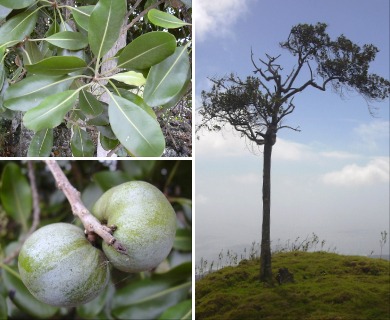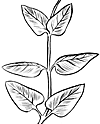ʻĀlaʻa
Planchonella sandwicensis
Bully family (Sapotaceae)
Native species ()
Medium-sized native tree of dry forests mainly, with milky sap, recognized by the bronze or reddish brown lower surfaces of the leathery oblong or elliptical leaves. To 50 ft (15 ) high and 16 inches (0.4 ) in trunk diameter. Bark gray, thick, fissured to furrowed; inner bark orange with dark red outer layer, gritty and slightly bitter, with milky sap. Twigs with minute pressed brown hairs when young, with raised half-round leaf scars.

©2003 Forest And Kim Starr
Flowers 1–4 at base of leaf on straight or curved brown hairy stalks of about 3⁄4 inch (2 ), bell-shaped, about 1⁄4 inch (6 ) long. of five broad rounded light brown hairy with short tube and five broad rounded light green and hairless; five short attached within tube and and five small sterile (staminodia) in notches; and with hairy conical five-celled and short
() elliptical, rounded, or pear-shaped, 1 1⁄4–1 1⁄2 inches (3–4 ) long, yellow, orange, or purplish black, dry. Seeds 1–5, about 3⁄4 inch (2 ) long, elliptical and flattened, with long scar, shiny yellow brown.
Wood yellow with black streaks, hard, straight grained, and with faint growth rings. Formerly used for house construction, o‘o (digging sticks), and spears.
The milky sap was used by the Hawaiians as birdlime for catching small birds.
Dry forests mainly, in dry gulches to moist ridges at 600–4000 ft (182–1219 ) elevation throughout the islands.
Special areas
Kokee, Wahiawa
Champion
Height 38 ft (11.6 ), c.b.h. 5.3 ft (1.6 ), spread 29 ft (8.8 ). Puuwaawaa, Kailua-Kona, Hawaii (1968).
Range
Hawaiian Islands only
Other common names
kaulu, āulu
Botanical
Sideroxylon sandwicense (Gray) Benth. & Hook. f., Pouteria sandwicensis (Gray) Baehni & Deg., P. puulupensis Baehni & Deg., Pouteria auahiense Rock, P. ceresolii (Rock) Fosberg, P. rhynchosperma (Rock) Fosberg, P. spathulata (Hillebr.) Fosberg.
This species, treated here as the only Hawaiian representative of its includes five or more variations formerly accepted as species.









